The Huawei Honor 8 Review
by Matt Humrick on October 13, 2016 8:00 AM EST- Posted in
- Huawei
- Smartphones
- Mobile
- Kirin 950
- honor
System Performance
Inside the Honor 8 is a HiSilicon Kirin 950 SoC, with four ARM Cortex-A72 CPUs running at up to 2.304GHz and four Cortex-A53 CPUs running at up to 1.805GHz, paired with either 3GB or 4GB of LPDDR4 1333MHz RAM. We covered the Kirin 950’s performance and power efficiency in great detail in our Mate 8 review, so I will not delve into that again here. If you’re the curious type and have not already seen that review, it’s a very interesting read.
Like most recent devices, the Honor 8 offers a few different battery modes: Performance, Smart, and Ultra. The first mode obviously favors performance over battery life, while the Ultra mode severely limits the functionality of the phone—only allowing access to the dialer, messaging and contacts—and is only intended for situations when you really need to stretch battery life. The Smart mode, which is selected by default, tries to extend battery life by limiting peak performance in a way that does not noticeably degrade the user experience. Based on a casual investigation, there does not seem to be an obvious difference in how the Performance and Smart modes handle the A72 cores, but the Smart mode drops the target frequency for the A53 cores in moderate workloads from 1.5GHz to 1.3GHz. In order to see what effect this has on performance and battery life, I ran PCMark using both modes. All of the other tests use Performance mode.
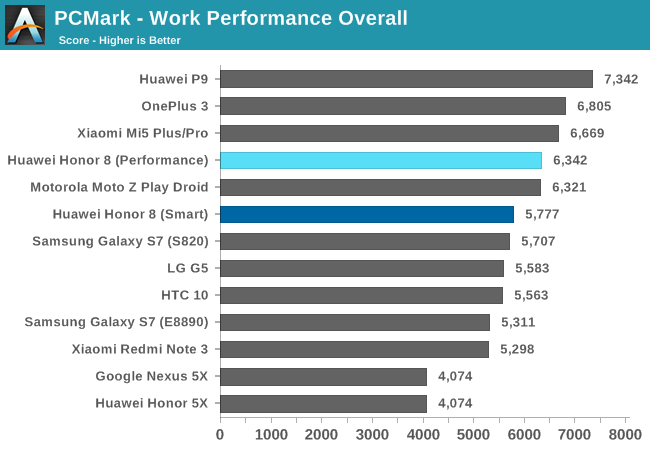
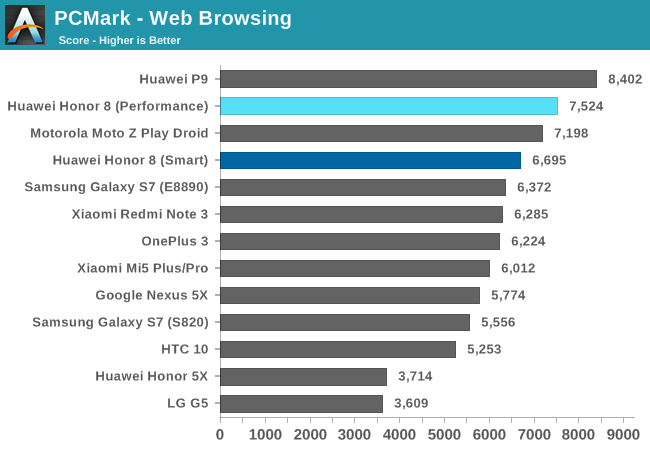
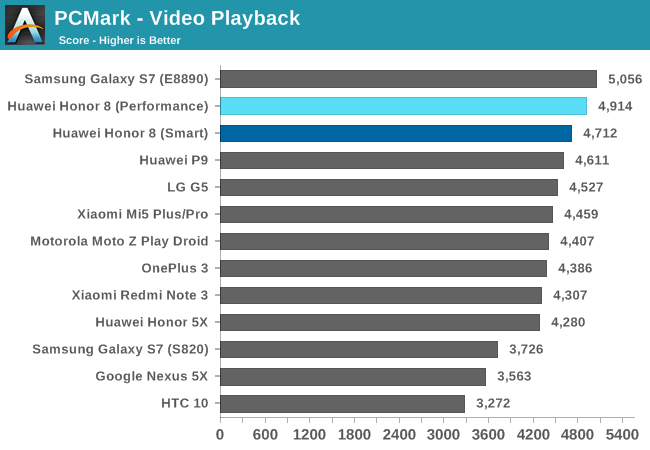
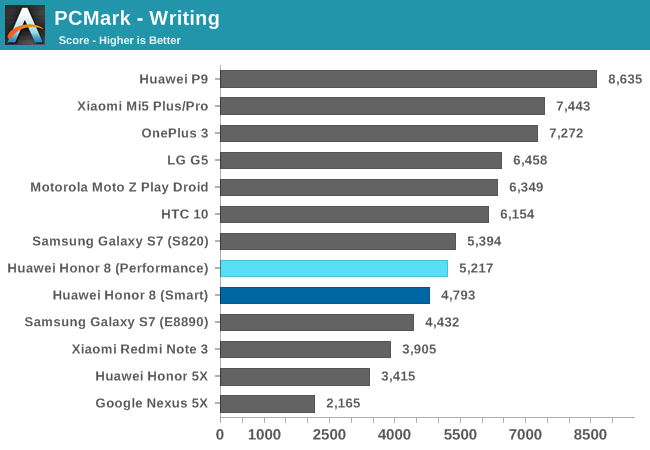
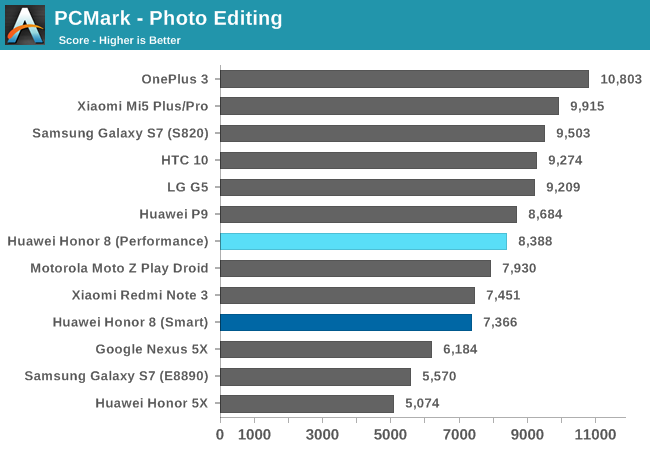
PCMark evaluates overall system performance by running real-world workloads that exercise the CPU, GPU, RAM, and NAND storage. Instead of running synthetic micro-benchmarks that run the CPU(s) only at peak frequency, its workloads rely on the same Android API calls many common apps use, eliciting realistic behavior from the CPU governor.
The Honor 8 finds itself surrounded by phones running Qualcomm’s Snapdragon 820 SoC in this test, at least when looking at the overall score; however, it fails to achieve the same level of performance as Huawei’s flagships, the Mate 8 and P9. Even more curious, though, is how phones with “5X” in their name manage to achieve the same score, and how the Moto Z Play Droid, with its mid-range Qualcomm Snapdragon 625 SoC that only uses A53 CPUs, matches the overall performance of the Honor 8. Just because an SoC uses a CPU with a more sophisticated architecture or reaches higher peak frequencies does not guarantee superior performance. There are many parameters OEMs can adjust in software that impact user experience.
This becomes obvious in the Web Browsing test where the overachieving Moto Z Play outperforms the Snapdragon 820 phones and even the Galaxy S7 with Exynos 8890. The Honor 8 and Huawei P9 do even better in this test, with the Honor 8 scoring 18% higher than the Galaxy S7 (Exynos 8890) and a more substantial 43% higher than the HTC 10 in Performance mode. Switching the Honor 8 into Smart mode reduces its score by 11%, which is not unexpected based on the small reduction in frequency for the A53 cores.
The only place where the Honor 8 falters a bit is in the Writing test, which is very sensitive to how aggressively the CPU governor utilizes the high-performance cores. With this workload, the Honor 8 slots in between the two different versions of the Galaxy S7 and falls behind the Snapdragon 820 phones such as the HTC 10 and OnePlus 3. Because this workload makes better use of the A72 cores, switching the Honor 8 into Smart mode only reduces performance by 8%.
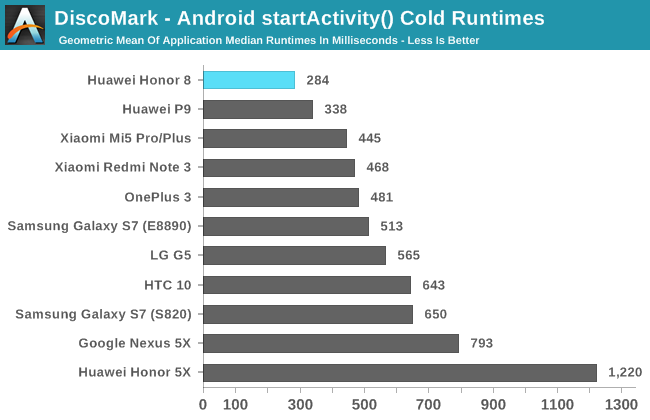
DiscoMark measures application launch times by taking advantage of Android's accessibility services to monitor an application’s startActivity() method, and the cold launch test reflects how quickly a phone opens apps from internal storage.
It’s interesting to see the phones from Huawei and Xiaomi perform so well. Except for the Nexus 5X and Honor 5X, all of the phones on this chart feel reasonably fast when opening apps, but with the Honor 8, it feels nearly instantaneous in some cases, opening this particular subset of apps 41% faster than the OnePlus 3 and 56% faster than the Galaxy S7 (Snapdragon 820).
These results illustrate that there’s more to this test than NAND or CPU performance. Just like with PCMark, software tuning plays a significant role here too. For example, Huawei mentions its “smart file-processing system” that aims to deliver a smoother user experience. While a system implies many different parts, one thing it seems to employ is more aggressive filesystem caching in the kernel. All modern operating systems, including Android, will cache disk reads and writes in a RAM cache to hide or reduce the latency of accessing internal storage. By using a larger cache, it’s more likely it will still hold a portion of the app’s code in RAM, bypassing the NAND and speeding up launch times.
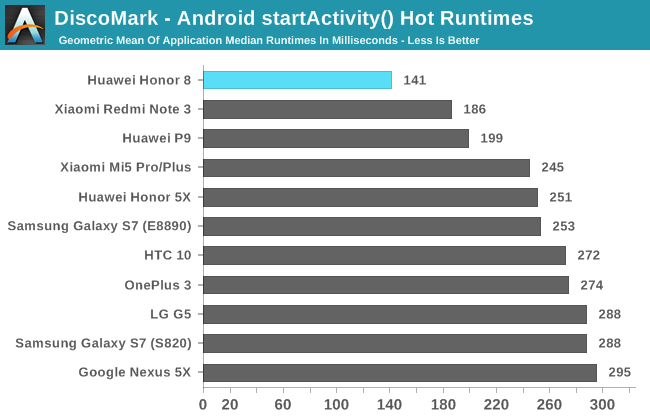
When switching between apps that are already open and sitting in RAM, the Honor 8, along with Huawei’s and Xiaomi’s other phones, rise to the top of our chart once again. Even the Huawei Honor 5X, a lower-cost phone with a Snapdragon 616 SoC and 2GB of LPDDR3 RAM, finishes ahead of the latest flagship devices. Differences here are less noticeable, however, because all of these phones switch between apps quickly.
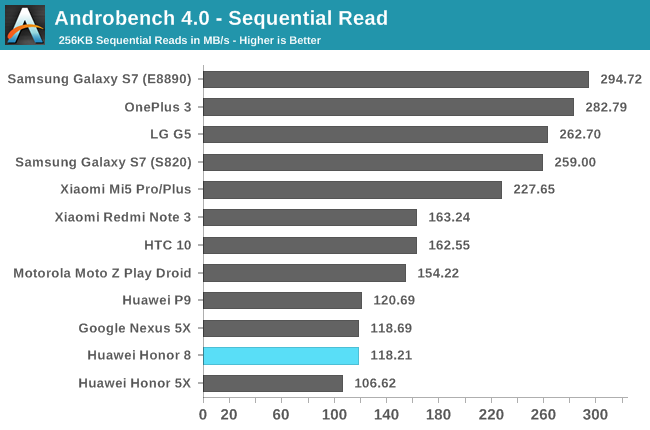
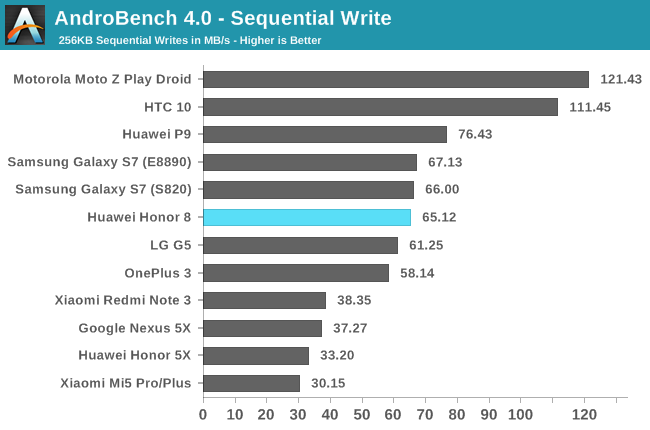
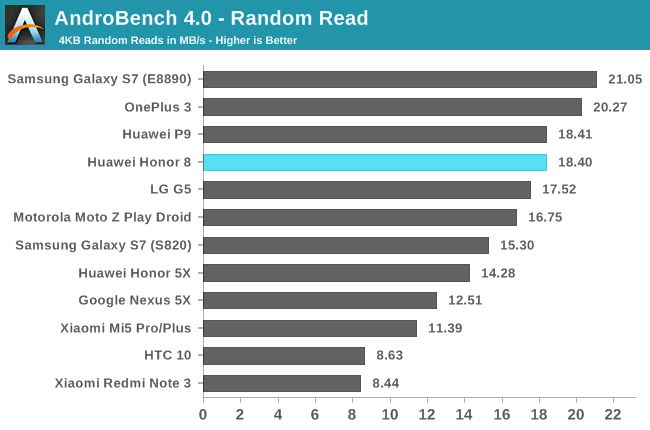
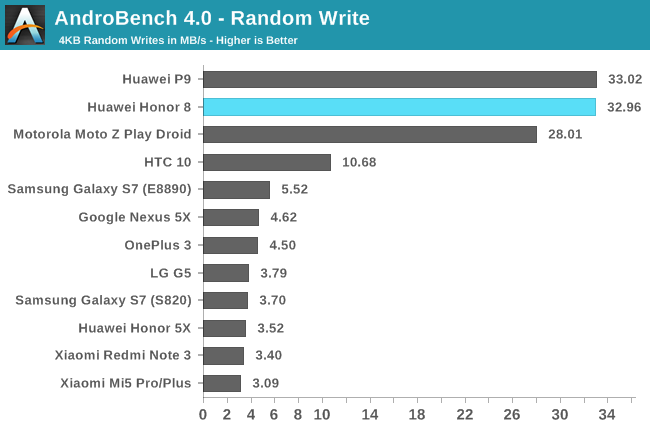
In our synthetic storage test, the sequential read performance of Huawei’s Honor 8, Honor 5X, and P9 is uninspiring, barely passing 120 MB/s when most flagship Android devices are hitting 250 MB/s to 300 MB/s. Sequential write performance is about average, matching the Galaxy S7.
Huawei seems more concerned with random performance; both the Honor 8 and P9 handle 4KB random reads and writes quite well. Their random write speed really stands out, performing 3x better than the HTC 10 and more than 7x better than the OnePlus 3.
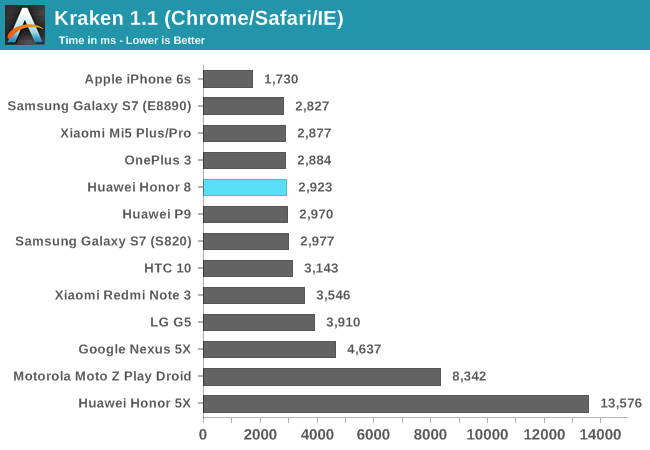
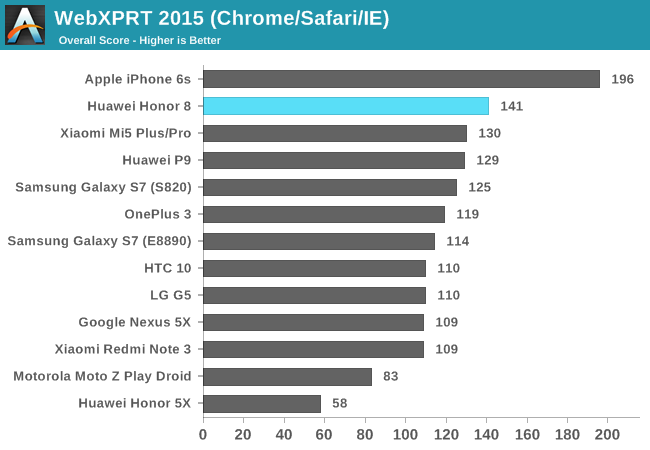

The Honor 8’s ARM CPUs perform well in our browser JavaScript tests. It’s on par with the current Android flagships in Kraken and holds a small advantage over the Snapdragon 820 phones in WebXPRT 2015 and JetStream.
My subjective experience with the Honor 8 confirms the data above: The Honor 8 is a fast phone. It handles common tasks such as opening and switching between apps, loading and scrolling web pages in the browser, and searching the inbox for an email with ease. The user interface remains buttery smooth while scrolling through home screens, opening and scrolling the task switcher, and pulling down the notification shade. It will drop a frame or two when you first interact with an object, say grab the notification shade or tap an icon, but the pause is so brief that it’s basically imperceptible to the human eye. Huawei has done a good job optimizing the Honor 8’s performance.


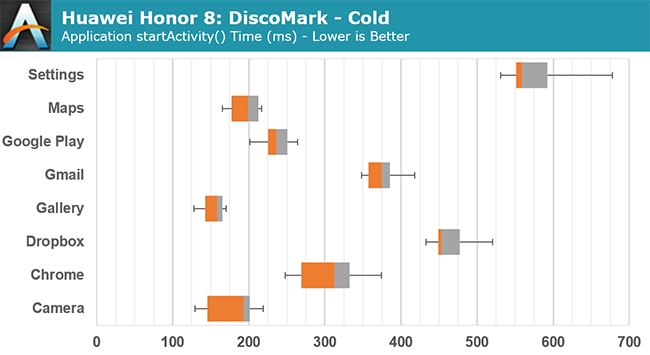
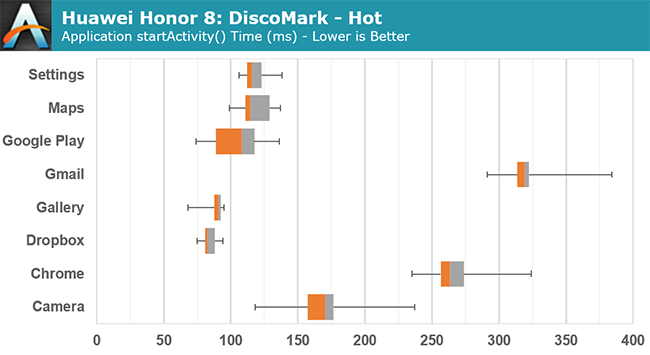








95 Comments
View All Comments
rarson - Wednesday, October 19, 2016 - link
Qualcomm is a company, not an SoC. Since you obviously missed his point, he was comparing compatibility of Qualcomm's Adreno graphics to ARM's Mali graphics.I own a phone with Mali graphics and I can attest that I have more compatibility problems with Mali than I've had with PowerVR or Adreno graphics.
tipoo - Thursday, October 13, 2016 - link
At least this goes for A72 cores rather than sprinkling 90 A53 cores in there.
Are all those cores needed, probably not, but at least it has some decent per-thread performance on the big cores to back it up.
s.yu - Thursday, October 13, 2016 - link
In the Chinese market, some will buy just because it's a Huawei. The stupid fanboys.UtilityMax - Thursday, October 13, 2016 - link
As opposed the highly educated people who buy LG, Samsung, or iPhones? Please. Is this why every grocery store or gym front desk clerk seems to be using a Samsung Galaxy or Apple?Ethos Evoss - Wednesday, October 19, 2016 - link
You sir are PROPER pathetic/naive person!Fidelator - Wednesday, October 19, 2016 - link
Sir, you are poorly educated yourself, read the review before commenting, the CPU in the Kirin is both faster and more efficient then the one in the 820The_Assimilator - Thursday, October 13, 2016 - link
Maybe because IT'S A F**KING PHONE.BrokenCrayons - Thursday, October 13, 2016 - link
One time I spent the afternoon screaming at my dresser for its lack of GPU power. It was several hours later and with a hoarse voice that I sheepishly realized I should probably have been screaming at my desktop PC instead. The neighbors heard my ravings through the wall. I don't think they want to talk to me anymore and it feels awkward when I come home from work and we happen to cross paths outside.Thanks to people like The_Assimilator reminding us of reality, it probably won't happen here in AT's comments box.
tipoo - Friday, October 14, 2016 - link
That's pretty myopic. Improvements to the GPU just as well as the CPUs over the years in phones have allowed richer content. People were asking "Why this much power in a phone" for years, yet older models can struggle in new apps and rich internet media.
svan1971 - Thursday, October 13, 2016 - link
$